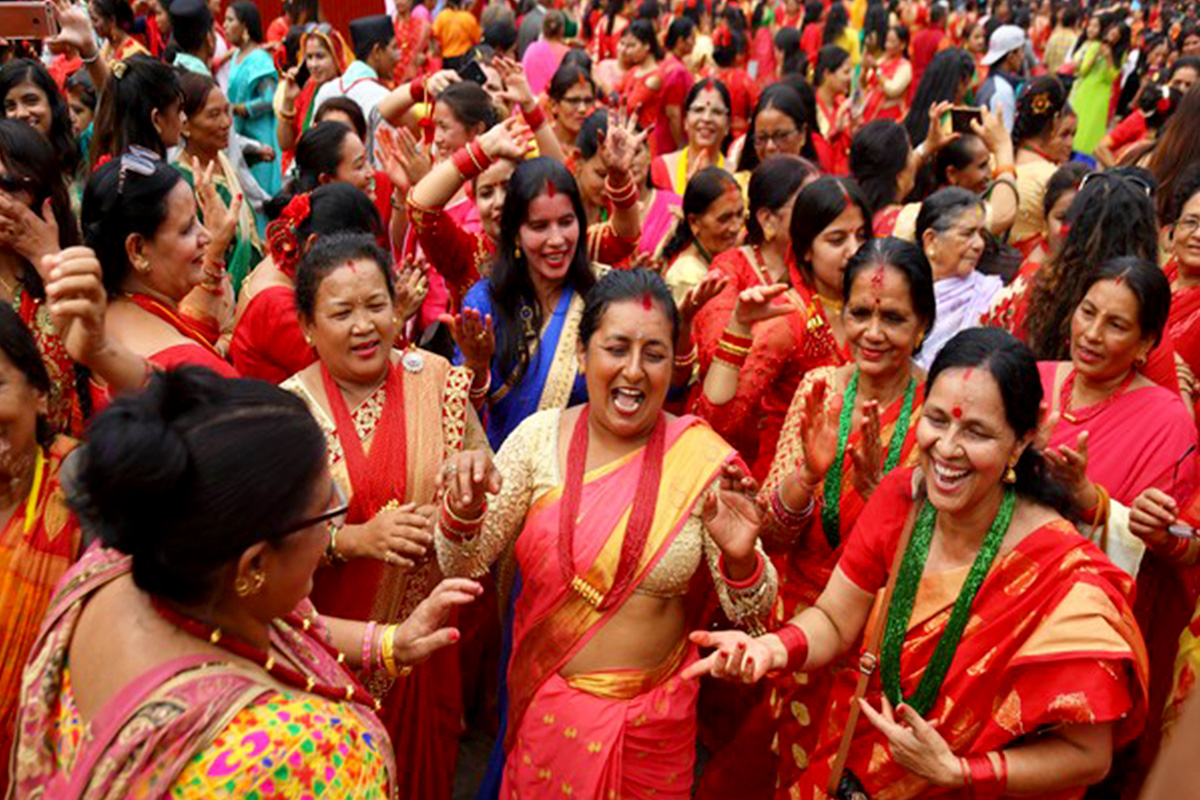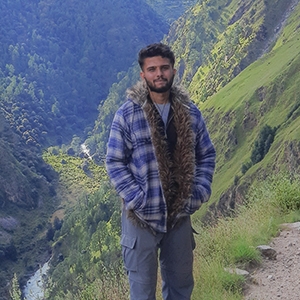The Nepali Teej festival, also known as Haritalika Teej, is the most elegant festival in Nepal coming at the end of the rainy season. On the special occasion of this festival, unmarried girls look forward to a pleasing marriage in the future, and married women pray for the healthy and long life of their husbands. The festival of Teej is primarily devoted to Goddess Parvati and her union with Lord Shiva. Occurring around the month of August or September, Teej is a festival celebrated by women all over Nepal for three days. Beautified in exquisite red sarees, bangles, and red tika, women sing and dance to traditional folk songs for days. Women and girls worship Goddess Parvati with prayer rituals, singing and dancing, and the yearning and belief that Parbati will bless them with a happy married life. On this particular occasion, parents invite their married daughters to their homes to celebrate the festival together. It is especially significant for married women when they get a special invitation to visit their motherly home and feast. Also, in some parts of India, this festival is celebrated as Hariyali Teej with full joy and entertainment.
The implication of such a festival is for women to ask for special blessings from Lord Shiva, to acquire a good husband in life, and to pray for his worth and longevity. A tradition of Haritalika Teej is that girls play swings while in-laws, husbands, and other family members give gifts, typically new clothes and accessories, to women and girls. Following a long feast, also known as Dar, the women sit for a 24-hour fast where most do not eat or even drink water. What is fascinating is to watch women of all age groups dance for hours in the scorching heat and rain without a drop of water or food for an entire day. Adding to Teej’s spirit are Teej’s folk songs and original music. Every year, hundreds of new Teej anthems come and go, with different musical signatures in Teej’s morale. Whether it is a song played on a loudspeaker or with clapping, the significance of music is very high and intense in Teej, whether it is improvised, whether it sparks the aroma of Nepali soil. This festival is also celebrated in some parts of India.
In order to protect the traditional culture, the government of Nepal has made the Teej festival a national holiday. Although Teej is widely deemed as a women’s festival, it is very important for both men and women. Just as women have been allowed to fast for their husbands and future husbands, there is no such thing as a fast dedicated to women. However, by bearing their responsibilities, men can be more responsible for women, increase their love and harmony, and sustain their love for as long as they live. This year, the Teej falls on Wednesday, 26th August, 2025.
The origin of the Teej festival (myths behind the celebration)
After Parbati fasted for Teej, intending to get Lord Shiva as a bridegroom, there is a belief that Teej has become prevalent. Today, Shiva temples and shrines have a special crowd of pilgrims. For a long time, the king of the Himalayas had a beautiful daughter named Parbati, who intensely esteemed the Hindu god, Shiva. But the king decided to marry Parbati to the wealthy Lord Vishnu. Ignoring the marriage proposal, Parbati successfully escaped from the house and hid in the forest. From that day, she led a monastic life. Upon hearing this, Lord Shiva was surprised and decided to test her seriousness. He changed his appearance as the rich Vishnu to see Parbati, trying to entice her to marry him. However, Parbati still remained unruffled. Shiva was so surprised and impressed by her determination that he revealed his identity. At last, Parbati realized and married Shiva. Parbati was so happy and grateful to her friends that she held a party to celebrate this happy ending. This is the origin of Haritalika Teej.
How is the Teej festival celebrated?
The Teej festival would last for three days, including enjoying a grand feast popular as Dar Khane Din, observing stringent fasting, bathing in the holy river, presenting traditional performances, and praying to Lord Shiva. The three days are categorized as feast days, fasting days, and Rishi Panchami.
Day 1
The first day is celebrated as “Dar Khane Din,” where women gather together in a place wearing beautiful red clothes. They dance together, sing folk songs, and have special food called Dar (which includes dishes made from milk products). It is celebrated with relatives and with close ones just ahead of the fasting day. Nepalese ladies from all over the globe have initiated celebrating the festival in their individual regions. Small events are organized to celebrate this auspicious occasion.

Day 2
This day is the fasting day of the Teej festival. After having a warm bath, women will wear beautiful silver or gold jewelry and dress in their red sarees. Then they head in squads to Shiva shrines nearby and offer flowers and fruits to God Shiva. What’s interesting is that on this day, women who are celebrating cannot eat anything from morning till night. They fast for the entire day. It is strongly believed that it will bring good fortune to their husbands. At the end of the main Teej festival day, women eat some fresh fruits and drink crystallized sugar water. You must be amazed at their strong wishes and faith for a better life.
Day 3
The last day of Teej is known as Rishi Panchami and is considered the most precious day of the festival. On this day, women wake up early in the morning and take a holy bath. They worship by offering money, food, and various other offerings to the seven saints (Rishis) of Hindu culture with a pure soul. Nepali women bathe in red mud found on the roots of the sacred Datiwan bush, along with its leaves. It is believed that this symbolic bath will absolve them of all their sins. Then they worship the god Ganesh in the hope of achieving the wishes made on the previous day. Many dishes are unique on this day, such as bean soup, mutton soup, and other special desserts.
Teej in the Pashupatinath Temple
The prehistoric Pashupatinath temple is adorned with red, vivacious, enthusiastic married and unmarried women. During the Teej festival, this holy temple is the top choice for women to worship Lord Shiva. On this day, red becomes the theme color, and Nepali women will try to make themselves as happy as possible so as to attract Shiva’s attention. According to Hindu mythology, Pashupati is the incarnation of Lord Shiva as an animal. People visit this sacred temple to worship Lord Shiva and to pray for the happiness and good health of their families. Thousands of Nepali women visit the Pashupatinath temple during the Teej festival. They worship and dance for a whole day on the special occasion of the auspicious Haritalika teej.

This sacred festival is considered the major festival celebrated by women in Nepal. You will get a chance to experience the celebration of Teej while you are in Nepal around the month of August. But, this year because of Malamas (the month without occasion/extra month) the Teej festival falls on 26th August, 2025 i.e. Bhadra 10, 2082. For more information on the Teej festival in Nepal, feel free to contact us.




